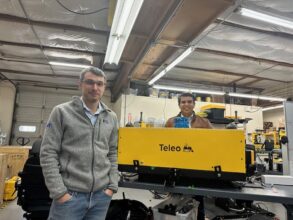
Venture West Preview
Palo Alto-based Teleo is converting existing fleets of heavy equipment into semi-autonomous robots, allowing operators to control multiple machines from a remote station, where they can switch between machines and also between jobsites. Rather than pursuing a fully autonomous strategy or a fully remotely operated strategy, Teleo allows machines to be autonomous in certain times and then remotely operated during more complex operations. In this way, a single operator can control more than one machine from a safer, cleaner environment.
How They Benefited From the Bay Area Ecosystem
Teleo is a perfect illustration of how the Bay Area continues to be so dominant in tech in the sector. In advance of our Venture West conference in San Francisco, we had the opportunity this week to visit with Teleo co-founder and CEO Vinay Shet at Teleo’s Palo Alto headquarters. Prior to Teleo, Vinay was the director of product management at Lyft working on building Lyft's self-driving cars. Taking what he and others at Teleo learned from their prior experience at Lyft and Google, the team is now addressing the increasingly critical challenge of the growing global shortage of construction equipment operators.
Why They Are Gaining Traction Now
While remotely operable and even autonomous construction equipment has been in development for many years now, Teleo showed us how they are actually achieving commercial success in several areas around the United States and in Europe with a "hybrid" approach to autonomy and remote operability, and also a lightweight system that is OEM agnostic, not to mention an impressive network of dealer relationships that are key for field deployment and support. As a result, Teleo appears to be overcoming some of the critical pitfalls other robotics companies have faced.
What this Tells Us About the State of Advanced Construction Equipment
BuiltWorlds will be spending a lot more time on this topic as our Tools, Equipment and Robotics Research Track kicks off this summer, but in the meantime, there are several important signals in the work that Teleo is doing:
- It shows that an ecosystem of truly viable tech companies is taking shape around the major OEMs, agnostic of the OEMs. This is a critical, positive development in our view because the OEMs appear to be more conservative and, therefore tend to take longer to introduce innovation to the market. In some respects, efforts to focus on their own proprietary systems may be further hindering their ability to participate in the development and commercialization of important new technologies in the industry.
- Emerging technology companies may be getting more savvy about pursuing short and long games in their roadmaps. In this case, for example, the “hybrid” approach may make Teleo more accessible to contractors today who are comfortable with remote operability, even as the company learns to provide increasing levels of autonomy in the future.
The Road Ahead
Although the industry is still not at a stage of widespread adoption of advanced equipment and robotics, companies in this part of the sector are becoming much smarter about identifying lower hanging fruit and going to market with solutions that meet contractors where they live. Early players like Built Robotics, Ekso and Fast Brick Robotics captured the industry’s attention almost a decade ago when they started making the rounds. Today, the industry can look to solutions, some from those companies and many from others, that are increasingly able to meet the industry’s needs today, even while positioning for tomorrow.

Discussion
Be the first to leave a comment.
You must be a member of the BuiltWorlds community to join the discussion.